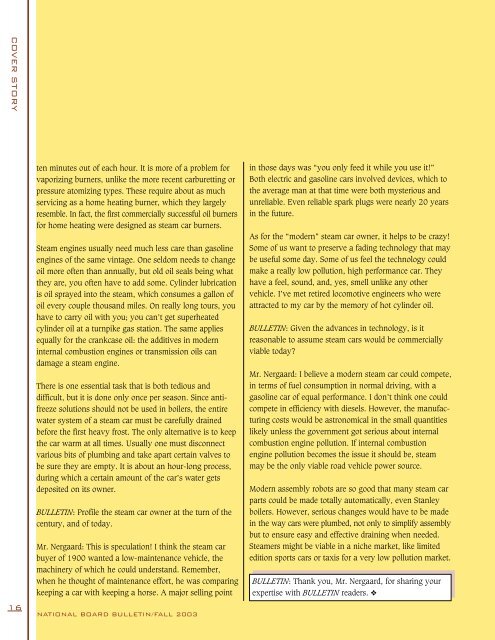bulletin - The National Board of Boiler and Pressure Vessel Inspectors
bulletin - The National Board of Boiler and Pressure Vessel Inspectors
bulletin - The National Board of Boiler and Pressure Vessel Inspectors
Create successful ePaper yourself
Turn your PDF publications into a flip-book with our unique Google optimized e-Paper software.
COVER STORY<br />
16<br />
ten minutes out <strong>of</strong> each hour. It is more <strong>of</strong> a problem for<br />
vaporizing burners, unlike the more recent carburetting or<br />
pressure atomizing types. <strong>The</strong>se require about as much<br />
servicing as a home heating burner, which they largely<br />
resemble. In fact, the first commercially successful oil burners<br />
for home heating were designed as steam car burners.<br />
Steam engines usually need much less care than gasoline<br />
engines <strong>of</strong> the same vintage. One seldom needs to change<br />
oil more <strong>of</strong>ten than annually, but old oil seals being what<br />
they are, you <strong>of</strong>ten have to add some. Cylinder lubrication<br />
is oil sprayed into the steam, which consumes a gallon <strong>of</strong><br />
oil every couple thous<strong>and</strong> miles. On really long tours, you<br />
have to carry oil with you; you can’t get superheated<br />
cylinder oil at a turnpike gas station. <strong>The</strong> same applies<br />
equally for the crankcase oil: the additives in modern<br />
internal combustion engines or transmission oils can<br />
damage a steam engine.<br />
<strong>The</strong>re is one essential task that is both tedious <strong>and</strong><br />
difficult, but it is done only once per season. Since antifreeze<br />
solutions should not be used in boilers, the entire<br />
water system <strong>of</strong> a steam car must be carefully drained<br />
before the first heavy frost. <strong>The</strong> only alternative is to keep<br />
the car warm at all times. Usually one must disconnect<br />
various bits <strong>of</strong> plumbing <strong>and</strong> take apart certain valves to<br />
be sure they are empty. It is about an hour-long process,<br />
during which a certain amount <strong>of</strong> the car’s water gets<br />
deposited on its owner.<br />
BULLETIN: Pr<strong>of</strong>ile the steam car owner at the turn <strong>of</strong> the<br />
century, <strong>and</strong> <strong>of</strong> today.<br />
Mr. Nergaard: This is speculation! I think the steam car<br />
buyer <strong>of</strong> 1900 wanted a low-maintenance vehicle, the<br />
machinery <strong>of</strong> which he could underst<strong>and</strong>. Remember,<br />
when he thought <strong>of</strong> maintenance effort, he was comparing<br />
keeping a car with keeping a horse. A major selling point<br />
NATIONAL BOARD BULLETIN/FALL 2003<br />
in those days was “you only feed it while you use it!”<br />
Both electric <strong>and</strong> gasoline cars involved devices, which to<br />
the average man at that time were both mysterious <strong>and</strong><br />
unreliable. Even reliable spark plugs were nearly 20 years<br />
in the future.<br />
As for the “modern” steam car owner, it helps to be crazy!<br />
Some <strong>of</strong> us want to preserve a fading technology that may<br />
be useful some day. Some <strong>of</strong> us feel the technology could<br />
make a really low pollution, high performance car. <strong>The</strong>y<br />
have a feel, sound, <strong>and</strong>, yes, smell unlike any other<br />
vehicle. I’ve met retired locomotive engineers who were<br />
attracted to my car by the memory <strong>of</strong> hot cylinder oil.<br />
BULLETIN: Given the advances in technology, is it<br />
reasonable to assume steam cars would be commercially<br />
viable today?<br />
Mr. Nergaard: I believe a modern steam car could compete,<br />
in terms <strong>of</strong> fuel consumption in normal driving, with a<br />
gasoline car <strong>of</strong> equal performance. I don’t think one could<br />
compete in efficiency with diesels. However, the manufacturing<br />
costs would be astronomical in the small quantities<br />
likely unless the government got serious about internal<br />
combustion engine pollution. If internal combustion<br />
engine pollution becomes the issue it should be, steam<br />
may be the only viable road vehicle power source.<br />
Modern assembly robots are so good that many steam car<br />
parts could be made totally automatically, even Stanley<br />
boilers. However, serious changes would have to be made<br />
in the way cars were plumbed, not only to simplify assembly<br />
but to ensure easy <strong>and</strong> effective draining when needed.<br />
Steamers might be viable in a niche market, like limited<br />
edition sports cars or taxis for a very low pollution market.<br />
BULLETIN: Thank you, Mr. Nergaard, for sharing your<br />
expertise with BULLETIN readers. ❖








